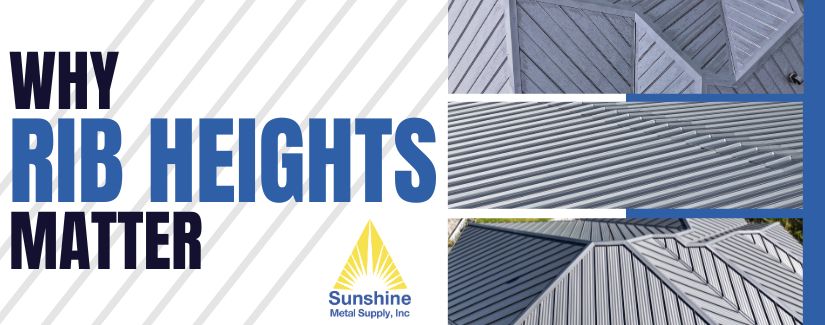Selecting a metal roofing system requires many considerations — rib height often being one of the most important. Sunshine Metal Supply understands the significance of selecting an appropriate rib height, so we offer various options to meet our customers’ diverse needs. This guide will explain the significance of rib heights, helping you make an informed decision and ensuring project success.
What Are Ribs?
“Ribs” refer to the vertical ridges on metal roof panels. They provide structural integrity, as well as add aesthetic value. Their height may differ, altering both performance and appearance of your roof.
Why Rib Heights Matter
Metal roof rib heights provide different advantages. Here is why it is important to pay attention to rib heights:
- Structural Strength: Taller ribs generally offer greater structural support.
- Water Drainage: Higher ribs improve water runoff.
- Aesthetics: Rib height can significantly affect the appearance of your roof.
At Sunshine Metal Supply, we offer metal roofing systems with various rib heights to meet your specific roofing needs.
Low Rib Height (0.5″ to 3/4″)
Our 5V Crimp metal roofing system offers an elegant and modern appearance. It can also be easier to install on complex roof shapes.
Medium Rib Height (3/4″ to 1″)
Versatile for both residential and commercial uses, our SUNRIB roofing system achieves balance between strength and aesthetics. It’s ideal for moderate weather conditions and suitable for standard roof slopes or lower roof slopes.
High Rib Height (1″ and above)
Sunshine Metal Supply’s SUNLOC line provides exceptional durability and performance. Constructed to withstand harsh weather conditions, this system is an excellent choice when choosing a high rib height. For coastal properties needing enhanced protection from elements, our Armored CoastTM panels also fall into this high rib height category.
When selecting the best metal roof rib height for your project, there are multiple factors to keep in mind:
- Climate: When climate conditions include heavy rain or snowfall, higher ribs help with drainage and load bearing.
- Building Design: Architectural styles may dictate which height ribs are used, in order to enhance or create the desired look.
- Roof Slopes: Steeper slopes often benefit from having higher ribs to ensure efficient rainwater runoff.
- Budget: Ribs with higher heights tend to cost more, yet offer increased durability and performance.
Each rib height offers distinct advantages. Here is a quick comparison:
- Low Ribs: Cost-effective. Easy to handle and install making them great for aesthetic applications.
- Medium Ribs: Good balance of cost and performance. Provides increased strength suited for diverse applications and most weather conditions.
- High Ribs: Heavy Duty. Designed for maximum strength and durability in harsh climate conditions. Offer the greatest resistance against water penetration – even on low slope roofs.
Understanding rib heights is integral for selecting a metal roofing system that suits your climate, building design, roof slope, and budget needs.
Sunshine Metal Supply is dedicated to offering metal roofing systems tailored specifically to the requirements of any project. We offer a selection of metal roof rib heights, ensuring both durability and aesthetic appeal. As your one-stop shop for metal roofing systems, our knowledgeable customer support team is here to assist you every step of the way. Reach out now and see why Sunshine Metal Supply is your trusted partner in all things metal roofing!

